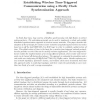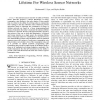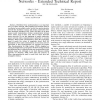25 search results - page 3 / 5 » Clock Skew Based Node Identification in Wireless Sensor Netw... |
SENSYS
2009
ACM
14 years 1 months ago
2009
ACM
Having access to an accurate time is a vital building block in all networks; in wireless sensor networks even more so, because wireless media access or data fusion may depend on i...
WISES
2008
13 years 7 months ago
2008
In South-East Asia, huge swarms of fireflies synchronously emit light flashes to attract mating partners. The underlying principle can be used to implement a robust and scalable d...
CISS
2007
IEEE
14 years 20 days ago
2007
IEEE
—The inherent many-to-one flow of traffic in Wireless Sensor Networks produces a skewed distribution of energy consumption rates leading to the early demise of those sensors that...
INFOCOM
2006
IEEE
14 years 11 days ago
2006
IEEE
— Distributed time synchronization is an important part of a sensor network where sensing and actuation must be coordinated across multiple nodes. Several time synchronization pr...
MDM
2009
Springer
14 years 26 days ago
2009
Springer
Location monitoring systems are used to detect human activities and provide monitoring services, e.g., aggregate queries. In this paper, we consider an aggregate location monitori...



